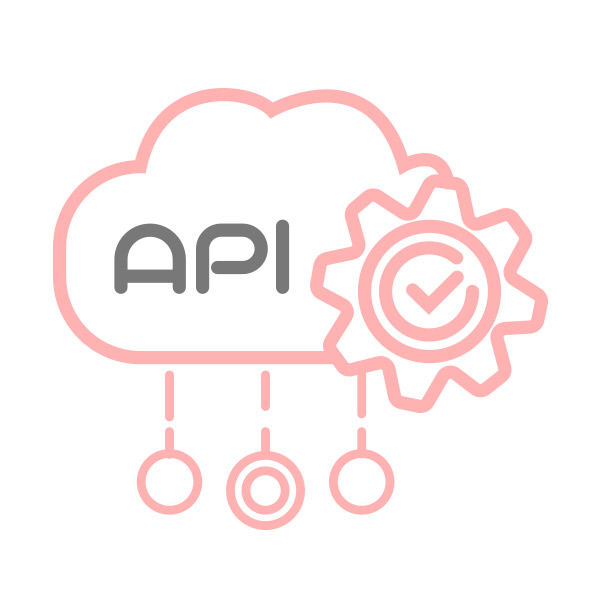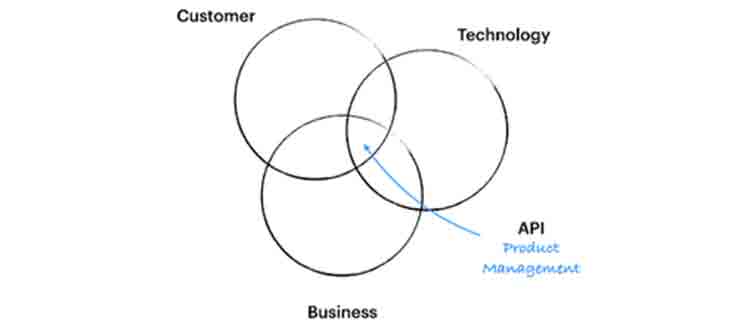This trend affects software companies and various areas such as telecommunications, information technology, etc. APIs are now recognized as an essential benchmark in industries where API-based regulation exists, such as the PSD2 banking standard or the FHIR standard for medical software. Jeff Lawson, CEO of Twilio, believes that every company today should become a software company.
So, it is crucial to plan carefully for a successful API strategy. In the following, we outline the key elements you need to have a successful API strategy. We'll also cover key topics that IT professionals and managers need to know before implementing an API.
What are the needs for having a successful API strategy?
The process of building sophisticated APIs is more than just coding. Teams should use product management methods throughout the API lifecycle.
When you think of your APIs as products, the API strategy is based on business value, customer needs, and technology. According to the image below, we analyze the details of each of these areas.
1. Know the value of your business
sful API strategy. We'll also cover key topics that IT professionals and managers need to know before implementing an API.
"The most important thing is to understand the value of your business," says Kirsten Hunter, author of Irresistible APIs.
First, let's take a look at the API business models and the type of value they generate:
Internal API: This is a dedicated API and is only used by your team or company. This API generates an indirect source of revenue or cost savings. For example, groups can meet all their needs in large organizations.
Partner / Customer API: This API is also proprietary and is only shared with partners. This API generates shared revenue and improves marketing.
External API: This is a public API that is freely available and often free on the web. This type of API can generate direct revenue with several strategies.
According to reports on the status of APIs in 2020, companies that use APIs extensively spend an average of 56.96% of their APIs on internal affairs. Prioritizing value-added over revenue generation, especially at the beginning of an API strategy, is crucial. Many businesses start with internal APIs and later make parts of their APIs available to the public, and in some cases, these APIs become a viable tool for business revenue.
APIs can improve business models. Today, many entrepreneurs and companies use a new business to Developer (B2D) model that focuses on developers and creates value for companies.
2. Know your customers
The second key to success is knowing your customers. Companies need to know the current and potential users well to understand their needs. A common mindset when building an API is that when you create it, users will use it. However, there is a better approach. When you are making an API, users can help you as a partner.
This partnership helps your team identify API use cases, understand user skills, and, most importantly, deliver higher value to customers. Early interaction with API customers allows your team to refine the design and build of the API before release based on BETA users' feedback. According to Google's 2021 API Economics Report, APIs enable organizations to accelerate the development of new applications, connect internal applications, and build a development ecosystem by 58%, 53%, and 47%, respectively. This report illustrates the importance of APIs in creating value for customers.
Knowing the skills of users is another critical issue. By understanding the skills of customers and users, you can provide them with the most appropriate API. According to the Postman API Status Report released in 2020, it is clear that Full-Stack developers are the most common API users. However, with the advent of low-code and no-code tools, the workload of many tech jobs such as network administrators, product managers, support experts, and UX designers is reduced.
Regardless of the API users, carefully design their architectures and create gateways to manage your most valuable data access. Many securities magazines report that more than 90% of organizations had a security API last year. Gartner also predicts that APIs will become a significant issue by 2022.
3. Treat the API as a product
Once you understand the value of the business and the customers you serve or products to, it is time to build your API.
First, you need to assume the API is a product.
Comprehensive API Documentation: According to 2020 reports, documents are one of the most important factors people consider before using the API.
If you want to create documents for the API, use standard templates to describe the API, such as the OpenAPI Specification (OAS), or use tools that automatically generate API documentation based on specific formats. Instead of creating a list of API operations and technical information, put use cases and API applications in the API portal so that developers can use the API without any problems. In addition, it helps developers speed up their work and helps business executives understand what kind of products can be created with the API.
Sandboxes: By creating sandbox environments, you allow API users to use APIs in environments other than software deployment environments. With sandboxes, developers can start testing and analyzing within minutes of reaching your API portal.
Launch the API: Like any product development program, carefully design your marketing strategy to segment customers and provide the most relevant services to each segment. Also, hire the top developers to take full advantage of the API.
Support: Consider additional or overhead costs that are imposed on the organization due to API support. But can developers contact support, or should they seek answers in the developer community? Feedback and information exchange cycles are done quickly. But for providing services to developers outside the organization, it is vital to create a society motivated by developers.
Create communication channels so that API users can express their questions and resolve problems. Some actions, such as creating links in API documents to provide direct feedback, enable developers to report API problems.
Measuring Success: Product managers determine Key Performance Indicators (KPIs) that help API teams to monitor performance and relate API adaptability to the value it generates for the business. The minimum API criteria to consider are:
- Revenue Indicators, such as ROI and customer lifetime value (CLTV)
- Operational Indicators, such as uptime and errors
- Development Indicators, such as Net Promoter Score (NPS) to measure customer loyalty
The best API models
Now that you know exactly what you need to create a successful API, some examples are the best APIs.
TWILIO
API model: External API with coin business model (for example, $ 0.0075 for sending or receiving messages or SMS)
Twilio is an excellent example of a leading API company. Jeff Lawson, CEO of Twilio, stated in 2008: "We've taken away the whole chaotic world of the phone and made it a better world with the API." Since then, Twilio has been valued at $ 57.7 billion in the market.
Before founding Twilio, Lawson was a technical product manager at Amazon and knew how Amazon launched AWS with APIs and transformed its business.
What makes Twilio APIs unique is the entire screen for real-time examples of using APIs with SDKs compatible with various popular programming languages such as Java and Node.js.
STRIPE
API model: External API with transaction fee) For example, $ 0.3 for credit card money transfer ( Stripe is a collection of payment APIs that pave the way for online business. The company was founded in 2010 and is currently worth $ 95 billion.
What makes Stripe so successful is that it has a flexible and robust payment platform. Companies can integrate and sync with the Stripe platform via the API instead of building the infrastructure for payment transactions. Since Stripe manages all trades, there is no need to build infrastructure or hire people. Therefore, this will significantly increase efficiency and save costs.
HUMAN API
API model: Customer APIs with pricing levels (e.g., clinical API, enterprise API) Successful APIs are used in a variety of fields.
When the COVID-19 pandemic broke out, clinics and hospitals needed to return to normal. Hence, many of these organizations have found that using the Human API is the best solution. The CLEARED4 and Human API teams recently agreed to provide real-time data from COVID-19 to organizations that use it to conduct research, provide medical care, and more.
Ashley John Heather, CEO of CLEARED4, said: "We knew that real-time access to Covid-19 data was critical to the reopening of offices, universities, schools, and more. For this reason, medical and clinical APIs enabled our team to seamlessly integrate test results and all COVID-19 data into the return-to-work platform to obtain accurate and valuable information.
Conclusion
APIs play an essential role in our lives today. They provide various services, bring innovation for organizations, reduce costs, and allow developers to meet their needs in the simplest possible way. Developing a successful API strategy is the most crucial step in creating value and transforming a business. Prioritize this issue to gain customer satisfaction and respond to emerging needs as quickly as possible.














